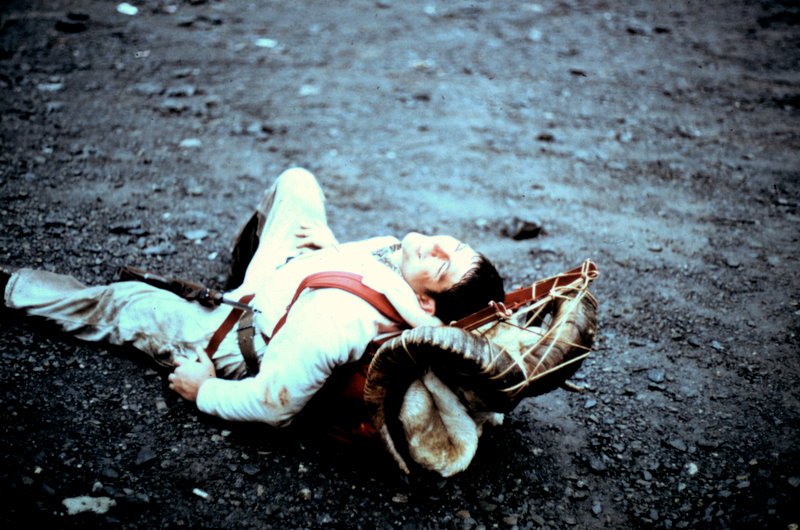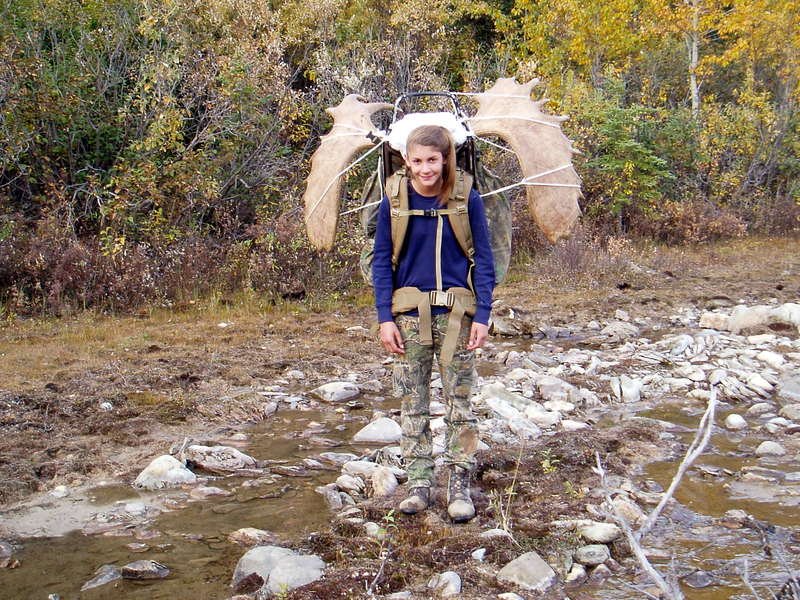It’s been almost a year since I wrote my last story and I have received comments from a few subscribers asking when I was going to write another one. My current plan is to only write one after a new hunt. However, at my age I’m just not hunting very often. I spend most of my time reminiscing about all of my old hunts especially when I get to talk to someone who has just returned from a hunt. I love hearing the details and always wonder if I could handle another tough hunt. I always believe I can but could I really. When I think back to some of the bad ones with long hard packs, I know more than likely I couldn’t do it. I still do fine with a 40-to-50-pound load, which is what I call a day pack, but every year even that seems to be more difficult.
One of my successful sheep hunts in glacier country. This was a hard pack. We had three miles of glacier moraine walking before we could get up on the glacier lip. Then another 10 miles of brush and tundra walking. Each carrying around 100 pounds.
Most of us Alaskan hunters have stories of hard packs. Most of them being long moose packs, but for mountain hunters they are usually long hard sheep packs. I would like to share some of my personal hard packs.
Packing out a mountain goat on one of my many goat hunts.
My first hard pack was in August, 1966. I had just taken my first animal in Alaska, a mountain goat. I was on a 60-degree incline mountainside in a small rock shale slide. After skinning and boning my goat, I loaded the meat and the full wet hide on my G.I. pack board. I was able to stand up but immediately sat back down thinking, “what have I done, there is no way I can do this.” But being 22 years old and able to disconnect my brain I stood and climbed slowly to the top of the ridge which was about 700’. I then walked in the dark for close to three miles on the 4000’ ridgetop to camp. I couldn’t believe how heavy my load was. It probably wasn’t over 80 pounds but with the G.I. pack board it was brutal. What an experience for this WV squirrel hunter. When I got home from that weekend hunt, I started modifying my G.I. pack board.
Me after a hard pack.
What is the definition of a hard pack? I think it is different for each of us. What is hard for me may not be for you or vice versa. I think there are three main elements that make up a hard pack. First is the weight that you will carry. Most of us can carry 40 to 50 pounds for long distances. I say 80+ pounds is a heavy pack but I have carried many over 100 pounds. Second is the distance that you will be packing. Most of us can carry a 100 pounds a couple hundred yards, but what about five miles? Third, you add the type of terrain. Many moose hunters end up packing in marsh, bogs or swamps. Sheep hunters pack in mountains with elevations, rocks, alder and for me the worst glacier country. So, take a 100+ pound pack, 20+ miles up a glacier and you have my hardest pack.
Typical sheep hunting glacier country.
Beautiful but tough country.
What you find where the mountain creeks run into the glacier. Tough to get around.
Camp site on the glacier.
It was in 1973, when I took the number 3 Pope and Young Record Book Ram about 22 scale miles from the drop-off strip. I’m sure it was somewhere between 25 to 30 walking miles of up and down, back and forth on the glacier moraine. It took me parts of three days. I started about midday after my friend and later my business partner, Brent Jones, was picked up by a helicopter. He had broken his ankle. I finished around noon two days later. When I got home, I weighed my pack and it was 99 ½ pounds. That was after eating food from the pack for three days. What really made it miserable was I was alone. I personally think being solo makes the pack much harder. Remember hard packs are as much mental as physical. There is something about someone sharing the same pain. You know like misery loves company!
My last hard pack at age 72. I was carrying 40-50 pounds which is what I always call a day pack. If I would have had another 20 pounds I don’t think I could have made it. See post “Getting Too Old for Back Packs.”
I have done at least four sheep hunts where my buddies and I were 100% successful. If no meat is damaged and you have the cape and horns plus your camp and gear your load will always be around 100 pounds. On one trip in the Tok area both Ron Watts and I harvested rams and I carried the complete skin including hoofs for a life size mount. That pack was around 125 pounds but it was only 10 scale miles with good mountain terrain and a creek bottom with good game trails. That makes a world of difference. It really wasn’t that bad of a pack. Not that I wasn’t glad when it was over.
The 73” moose that became known as the pack from hell.
The good thing about mountain and glacier terrain is you can sit down and rest and then get up without too much of a problem. Generally, there are no places you can stop and rest in marsh and swamps. That fact brings up a hard pack that my packers out in Western Alaska called, “the pack from Hell.” My son-in-law Sagen guided on the largest moose AAA had taken in Western Alaska, a 73 incher. The pack started in a creek bottom so the first thing the packers had to do was climb a 75 foot bank. Then they carried their 100 pound packs a mile and a half in swamp/bog terrain with a slight incline and finally a 50 foot climb to the strip. There was no place to rest except at the final hill. Then back for a second trip. I think they were ready to punch Sagen.
What a normal moose pack looks like on one of our family hunts. My grandson Jared on far right with his uncle Thor and cousins Jens and Jack. Fun day.
My hardest moose pack was in 1967, the first successful moose hunt that I went on. Being young and dumb my buddy Gary Wadkins killed a 60” moose about five to six miles from camp. It was hard ground with good game trails but it nearly killed us. It was good that we were young. You would think I would have learned my lesson but a few years later, there were four of us when Ron Watts shot another 60” moose about four miles from camp. Not as good walking as the six mile pack, but I only had to make two trips. Never again did we take one that far out and I would advise anyone not to do it unless you have a vehicle to retrieve it.
One of AAA packers and close friend, Scott Herbert, packing out a set of locked antlers. A 69” locked with a 56”. This was truly a hard pack not only because of the weight but because of the skulls hanging so far out. He had to stay bent over most of the way. About a three mile pack.
In the guide business I told all the guides not to take a moose over a mile and a half from where I could land. I told the clients that also. It’s just too hard on the packers. A 60+ inch moose front shoulder weights about 80-100 pounds and hind quarters weigh in at least 100-125 pounds even if you cut the top ham off. Over the years I had two packers that could pack two front shoulders at a time. That was unreal.
The spring of 1983 the year before I started guiding. I was packing out my 8’6” brown bear along with my camp and gear. My buddy the late Lyle Thompson and I both had taken a brown bear on Kodiak. We were back in 4 miles.
Packing brown bear is no easy task either, especially if it is over 9 ½ foot. With poor skinning the hide can weight over 100 pounds and if it is wet even more. We shipped a 10’10” after it was fleshed, lightly salted and semi dried that weighed 129 pounds. That included the skull. The good thing about brown bear packs is normally they aren’t too long.
Carrying out a clients 9’3” brown bear along with my gear. It was a little over 100 pounds and three miles inland. This was in our Cold Bay area.
Jeff Hamburg, started as a packer and here is an assistant guide. He packed this 11’3” brown bear, the largest that AAA had taken back to spike camp which was about two miles. Weighed at least 125 pounds.
The most important thing when packing these heavy loads long distances is a good quality pack frame. I have used everything including the G.I. pack board, the old Herman Nelson pack frame, an Expedition pack frame and numerous cheap aluminum tube frames. My personal opinion is you can’t beat the Gear of Alaska Freighter Frame with the Hunter Bag sold at Barney’s Sports Chalet. I haven’t used any of the new modern internal pack frames but I hate anything that rides flat against my back not allowing it to breath. Most of these do that. I just don’t think they are made for the 100+ pound loads. I know the Freighter works and it has a proven history.
Start them out early. My grandson Jared, age 13, packing out the antlers of his first moose.
Granddaughter Rachel at age 14 packing out the antlers of her first moose.
Grandson Nathan, age 15, packing out his first moose.
Good luck on those hard packs and remember when it gets tough it is all in your head, “you can do it.”

















